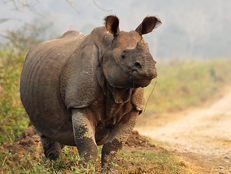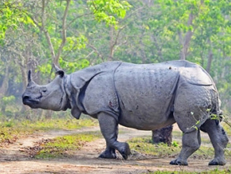Rhinoceros commonly known as Rhinos are one of the five extant species of one-toed ungulates. Rhinos family is one of the largest living members of megafauna. They exceed over 1-tonne weight, one or two horns, thick protective skin and hoofed toes, are the characteristic features of the Rhinos which makes them amazing mammals. But these characters are a threat to the mammal. They are counted among one of the endangered species of the world.
As human life is susceptible to non-visible viruses, the Rhinos are vulnerable to humans. Because of the persistent poaching and loss of natural habitat, the Rhino species are moving towards the end. The three species of Rhino are critically endangered–Javan, Sumatran and Black.
Rhinos once were independent species roaming in Europe, Asia and Africa. They were depicted in the cave paintings of European caves. The number of Rhinos has consistently declined after the 1970s. The early 20th century had approximately 500,000 of these animals, it records today only 2700 endangered Rhinos.
The COVID-19 pandemic though is a threat to human life, but it proved a great boon to rhinos, reveals the State of the Rhino Report by “The International Rhino Foundation”. The report states that as the international and the national boundaries are restricted in the response of a virus outbreak, the travellers are not permitted for international and domestic travel. It noticed a strict military, police and check-point enactment. It resulted in shutting the government parks and private reserves to all the visitors. Local poaching gangs found it risky to move without caution. This has resulted in providing a short term relief in poaching of rhinos. Lockdown followed by COVID-19 pandemic closed all international wildlife trafficking routes to the black markets, including the largest black markets of China and Vietnam.
In 2018, 900 Rhinos were killed by the African criminals, 1 each in 10 hours. South Africa noticed an increase in Black Rhinos 5,630 from 5,500. It drops the poaching from 319 in 2019 to 166 in the first half of 2020. Africa’s other species, the white Rhinos, have become extinct because of intensive poaching. It keeps the only two remaining northern white Rhino under 24-hour guard in Ol’ Pejeta Conservancy in Kenya. However, the species still remains under threat for its horns and habitat loss.
Coming to Asia, in Indonesia, less than 80 Sumatran Rhinos are left. This species is the most endangered mammal on the Earth, observing over 70% decline in the past 30 years. Iman, the last Sumatran Rhino, died in late 2019. Sumatran Rhinos, in response to continued habitat loss and fragmentation the Government of Indonesia, developed an emergency plan in 2017. The activities are to plan the rescue of Rhinos and bring the reproductive potential into extensive, semi-natural breeding and research facilities like the Sumatran Rhino Sanctuary in Way Kambas to increase population numbers.
There is no case reported of COVID-19 transfer from humans to Rhinos, as has been in case of other mammals. It implements a safety protocol in an abundance of caution for the seven Rhinos by the keepers.
The protected waters of Ujung Kulon represent a potential threat to the habitat of the lobsters and fishes. For such a marine patrol was launched in January 2020. In the first six months of 2020, 2 marine patrol units seized 45 boats and 218 people illegally encroaching in the park.
Habitat is merely essential for the survival of species. As the Javan Rhino population is increasing, habitat expansion and conservation are involuntary. Area of Ujung Kulon is under habitat expansion, and removal of ubiquitous Arenga Palm, which when cleared shall promote food resources.
Manas National Park, in India, had established a program in 2009, namely Indian Rhino Vision 2020 (IRV2020). It aimed to increase the Javan Rhino population to 41. Before COVID-19 breakdown, two greater one-horned Rhinos were translocated here in March.
India and Nepal have observed a strict increase in these species. Nepal planned to the census of their Rhinos in 2020 but postponed it by 2021 due to pandemic.
The Indian government and forestry officials have passed strict laws to reduce the poaching of Rhinos. In 2019, Assam recorded with three losses and just two incidents this year.
Kaziranga National Park (KNP) in this monsoon is recorded with the sixth-highest flood ever in 2020. Not only Rhinos died in this natural calamity, but also several other species perished. To fill the gap by loss of land and habitat, the Government intensified and postponed calls for actions.
The report outlines the following four priorities for all five species of rhinos:
Bolster anti-poaching activities or “boots on the ground” to meet the challenge of increased poaching created by economic losses.
Maintain intensive monitoring and active management of wild populations in the face of revenue losses, using conservation breeding where needed.
Work with local communities to ensure they are active participants in wildlife conservation and receive economic incentives that improve livelihoods.
Governments must commit to enforcing their wildlife crime laws and commitments to international treaties to foster more effective international collaboration on investigations to address the entire criminal supply chain, particularly in Asia.
Rhinos being extant mammals face a severe threat by intensive poaching, fragmentation and habitat loss, while habitat loss observed the most massive threat to survival. The COVID-19 breakdown is a hope to reduce the increasing poaching and ultimately the Rhinoceros.
Written by: Vaishnavi Jawalkar


